Redefining

Welcome
Recognizing Trailblazers and Icons in The Hispanic andCultureLatino CAMPUS



Redefining

Welcome
Recognizing Trailblazers and Icons in The Hispanic andCultureLatino CAMPUS



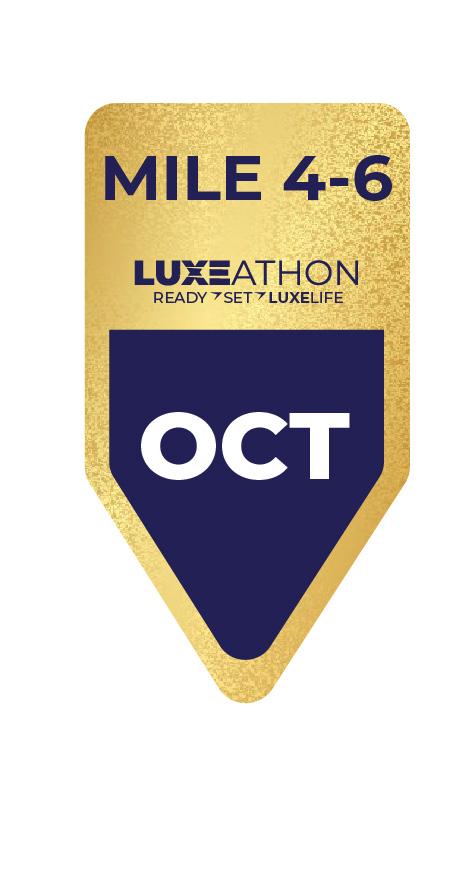
Approaching miles 4-6, take a moment to glance to your left and then to your right—you’ll notice everyone’s running at their own pace, with their rhythm, and chasing their own unique goals. And you know what? That’s the essence of the Luxeathon—it revels in the vibrant tapestry of diversity that colors our life’s racecourse. It acknowledges that each individual brings their own experiences, viewpoints, and backgrounds to the collective journey of humanity. So, let’s keep our minds open and make room on the path for everyone.
This month, we’re all about fostering an inclusive environment on campus where every person feels valued, respected, and empowered to thrive. Embracing diversity means not just tolerating but celebrating the differences that make each of us unique and recognizing the common humanity that binds us. In October, let’s celebrate Hispanic Heritage by sampling new foods, mastering life skills centered around diversity, and conditioning our minds to honor and respect everyone in this Luxeathon of life.
Have you suddenly grown tired of your favorites? Your favorite meal or favorite snacks? Food fatigue is a natural reaction, and breaking food fatigue is possible. This month, in honor of Hispanic Heritage, we are introducing healthy eating with a Latin flair! Healthy eating doesn’t have to be bland. By incorporating Latin spices into healthier options, you can explore the vibrant flavors and beauty of balanced eating.
Black beans are a staple in many Hispanic dishes, providing a rich source of both soluble and insoluble fiber. This fiber content aids in digestion, helps prevent constipation, and promotes a healthy gut microbiome, making black beans not only delicious but also beneficial for your overall health.
October is National Seafood Month (NSM), celebrating the richness of marine life and the importance of sustainable seafood practices. Join the movement by choosing responsibly sourced seafood options and advocating for ocean conservation in your community.

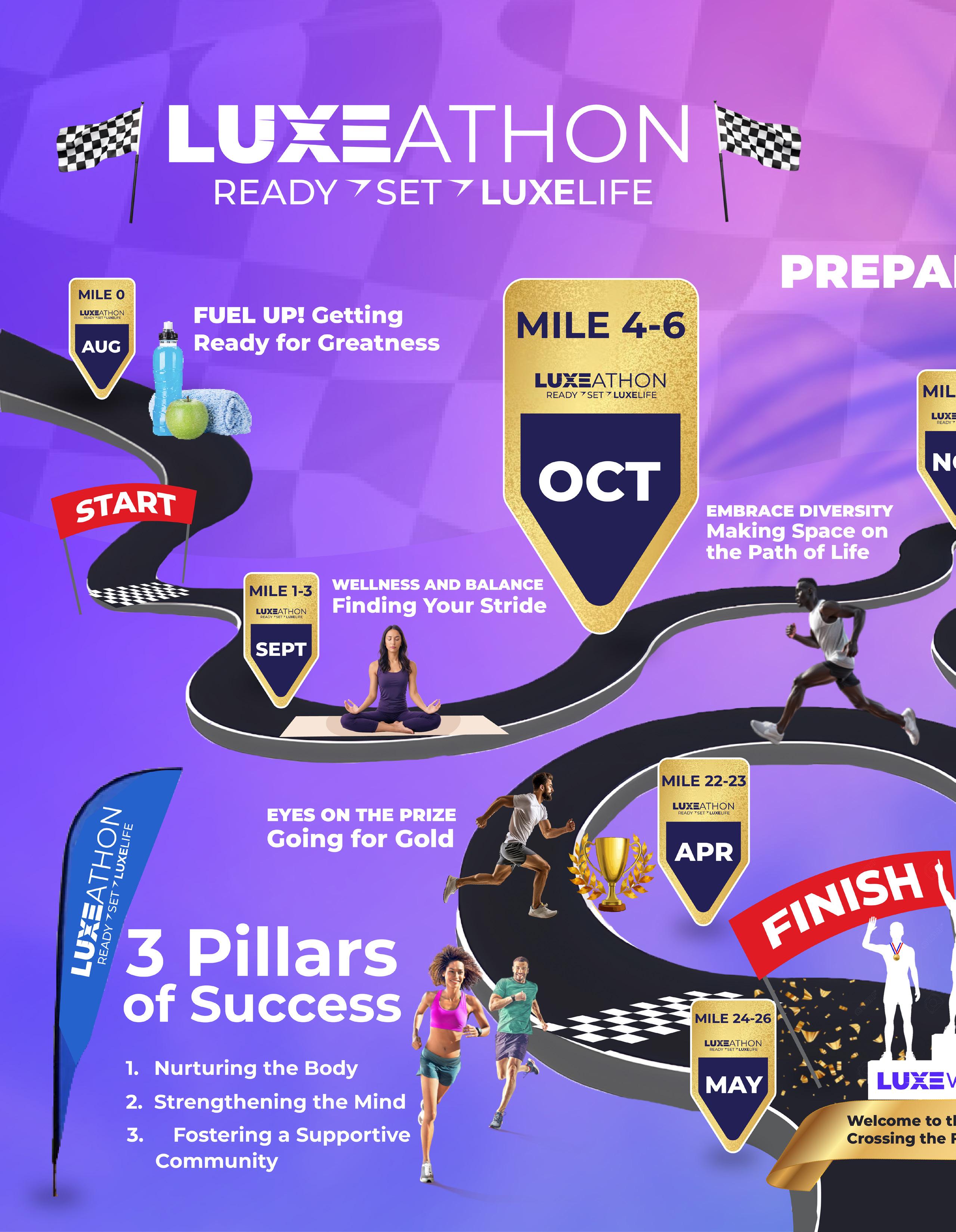
Fostering a Supportive


“Whoever said letters do not matter never got to wear these” “ - Anonymous
”
The role of National Pan-Hellenic Council (NPHC) can have a significant impact on your time in college. There are many diverse organizations on campus and becoming a member of the illustrious Divine Nine at your HBCU can enhance your undergrad experience. “Going Greek” impacts personal relations, respect, work ethic, etc. Greek culture also has a significant impact on family, community, and tradition.
The history of the Divine Nine dates back to the 20th century and has a great worth of history. African American students studying at HBCUs came together to create these organizations with principles focused on personal excellence, community service, racial uplift, and civil action. They used these organizations to connect and build support networks when predominately white Greek letter organizations were excluding African Americans. The birth of Black Greek-letter organizations is said to be characterized as a low point in American race relations. Four sororities and five fraternities known collectively as the Divine Nine make up the National PanHellenic Council. Each sorority and fraternity has its own colors, symbols, and calls that you’ll hear at any social gathering.







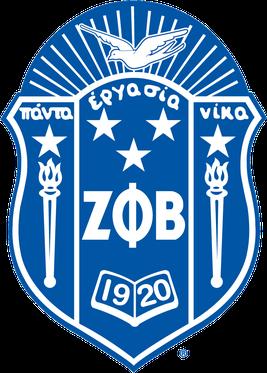


Greek life is inevitably a black experience. There could have been times when you’ve witnessed a stroll off between sororities, asked by a friend if you were going to join, or made sure not to step on a sacred plot. Greek life is all through HBCU’s history and is a pillar in black culture and it could play a huge role in your college life experience. Greek Life is more than colors, symbols, and calls it’s a significant cultural matter. The first African American male Greek fraternity was Alpha Phi Alpha Fraternity, Incorporated founded in 1906 at Cornell University. The first African American female sorority was Alpha Kappa Alpha Sorority, Incorporated, founded in 1908 at Howard University. Later in history the remaining four fraternities and three sororities were recognized, making them the Divine Nine.
Being a pillar on HBCU campuses comes with a lot of responsibility. You may see a member dressed in their lettermen jacket at a community service event distributing or collecting food, clothing items, or other necessities. You could see a member with a cane, such as Kappa Alpha Psi Fraternity, Inc. at a leadership or mentoring program for young people. You may even see legal representation in various cases sporting their Greek paraphernalia such as the Vice President of the United States, Kamala D. Harris.
NPHC has family ties to one another. It could be described as a sense of family that lasts a long time. Homecoming is one of those big events where it’s time for the family to shine. This is also a time for alumni chapters to welcome their members again, into a whole new world of community service, activities, and new bonds. NPHC’s still play a significant role on HBCU campuses today, as they did years ago. African American communities continue to face adversity, but having an organization who have the same principles, values, and goals could make running your Luxeathon™ more impactful while stepping into a rich history.



“Reading is a way for me to expand my mind, open my eyes, and fill up my heart”
- Oprah Winfrey

1. More Than Enough: Claiming Space for Who You Are (No Matter What They Say) by
Elaine Welteroth.
More Than Enough is an inspiring and empowering self-help memoir telling the story of Welteroth’s Journey as a black woman in media and fashion. This book is one of Stacey Gibson, Thompson Hospitality’s National Retail Director’s, favorite books. Throughout the story, Welteroth highlights the lessons and struggles of being a barrier-breaker across many intersections.
“When the world tells you to shrink, expand.” - Elaine Welteroth

4. Cinderella is Dead by
A young adult fictional book. This classic story invites you to imagine further how you thought the original Cinderella story ended. Yolanda Waters, Thompson Hospitality’s Corporate Marketing Coordinator, shared her insight on the book stating “It encouraged me to continue to fight against adversities. I realized there’s a lot of power in finding the strength to do so even when you are standing alone.”
“I don’t want to be saved by some knight in shining armour. I’d like to be the one in the armour, and I’d like to be the one doing the saving. “ - Kalynn Bayron

2. Power Moves: Ignite Your Confidence and Become a Force by
Sarah Jakes Roberts Power Moves
A book about confidence that will teach you how to expand and develop the principles required. Recommended by Thompson Hospitality Vice President of Marketing & Programming, Daniela Smallwood. Robert’s message is simple, the power or factors can help in the future. The ability to determine your truth helps unlock your full potential.
“Your power is not going to come from an opportunity, position, or person.”
– Sarah Jakes Roberts

5. The Four Agreements: A Practical Guide to Personal Freedom by Don Miguel Ruiz, Janet Mills.
The Four Agreements could be considered a self-help book. Recommended by Justin Kiaku, Thomspon Hospitality Digital Engagement manager. The authors base their code of conduct on Toltec wisdom. After applying the principles to your personal life you will gain a new experience of freedom, true happiness, and love.
“I will no longer allow anyone to manipulate my mind and control my life in the name of love..“ - Don Miguel Ruiz

3. The 21 Indispensable Qualities of a Leader by John C. Maxwell
A leadership-based book, that comes from a series of leadership laws; it helps readers integrate leadership principles into their everyday life. Recommended by Thompson Hospitality’s Campus Dining Marketing Coordinator, Jacquii A. Tilley. In this book, Maxwell provides concise, accessible ways that help readers become more effective leaders.
“Sustain character through stress to avoid the 4 A’s.” - John C. Maxwell

6. The Nightingale by Kristin Hannah
“I am a mother and mothers don’t have the luxury of falling apart in front of their children, even when they are afraid, even when their children are adults.” - Kristin Hannah

The Nightingale is a historical fiction novel based on two sisters in France during World War II divided by experience. Recommended by Joellen Allah-Mensah, Thompson Hospitality Graphic Designer. While enduring turmoil in life, both sisters embarked on different paths toward love, survival, and freedom. This book celebrates the human spirit.


7. Living A Life That Matters by Harold Kushner. Living A Life That Matters is a spiritual advice book that follows the biblical journey of Jacob. Recommended by Heaven Smallwood, Thompson Hospitality Operational Manager. This book stresses to readers that living a meaningful life is more than fame and wealth but about choices that align with values and how they impact others.
“Forgiveness is a favor we do for ourselves, not a favor we do to the other party. “ - Harold Kushner
Creating our own library with diverse types of books is essential for personal growth and broadening our perspectives. A well-rounded library introduces us to a variety of cultures, ideas, and experiences, enriching our understanding of the world. By exploring different genres and topics, we develop critical thinking skills, empathy, and creativity. This diversity in reading material shapes our future by preparing us for a globalized world, fostering openmindedness, and enabling us to approach challenges with innovative solutions. Investing in a diverse library is an investment in a well-informed, culturally aware, and adaptable future.


In the vibrant tapestry of American culture, the threads woven by Hispanic and Latino trailblazers stand out with vivid brilliance and undeniable influence. From the arts and sciences to politics and social activism, these pioneers have left an indelible mark on the nation’s history and identity. Their achievements and contributions have not only enriched the cultural landscape but have also paved the way for future generations to dream bigger and strive further. As we celebrate the remarkable impact of Hispanic and Latino leaders, we honor their enduring legacy and the profound ways in which they continue to shape and inspire American life.
Hispanic and Latino culture is a rich mosaic of traditions, languages, and histories originating from Spanish-speaking countries in Latin America, the Caribbean, and Spain. This culture is characterized by its vibrant music and dance, flavorful cuisine, colorful festivals, and deep-rooted values of family and community. In the United States, Hispanic and Latino culture has profoundly influenced American culture, enriching it with diverse perspectives and artistic expressions. From the infectious rhythms of salsa, merengue, and reggaeton that have become staples in American music to the culinary delights like tacos, empanadas, and arepas that have transformed the American palate, the impact is evident and far-reaching. Hispanic and Latino culture also brings a dynamic approach to storytelling in literature and film, providing unique narratives that reflect the multifaceted experiences of its people. This cultural infusion has not only enhanced the American way of life but has also fostered a deeper understanding and appreciation of diversity.


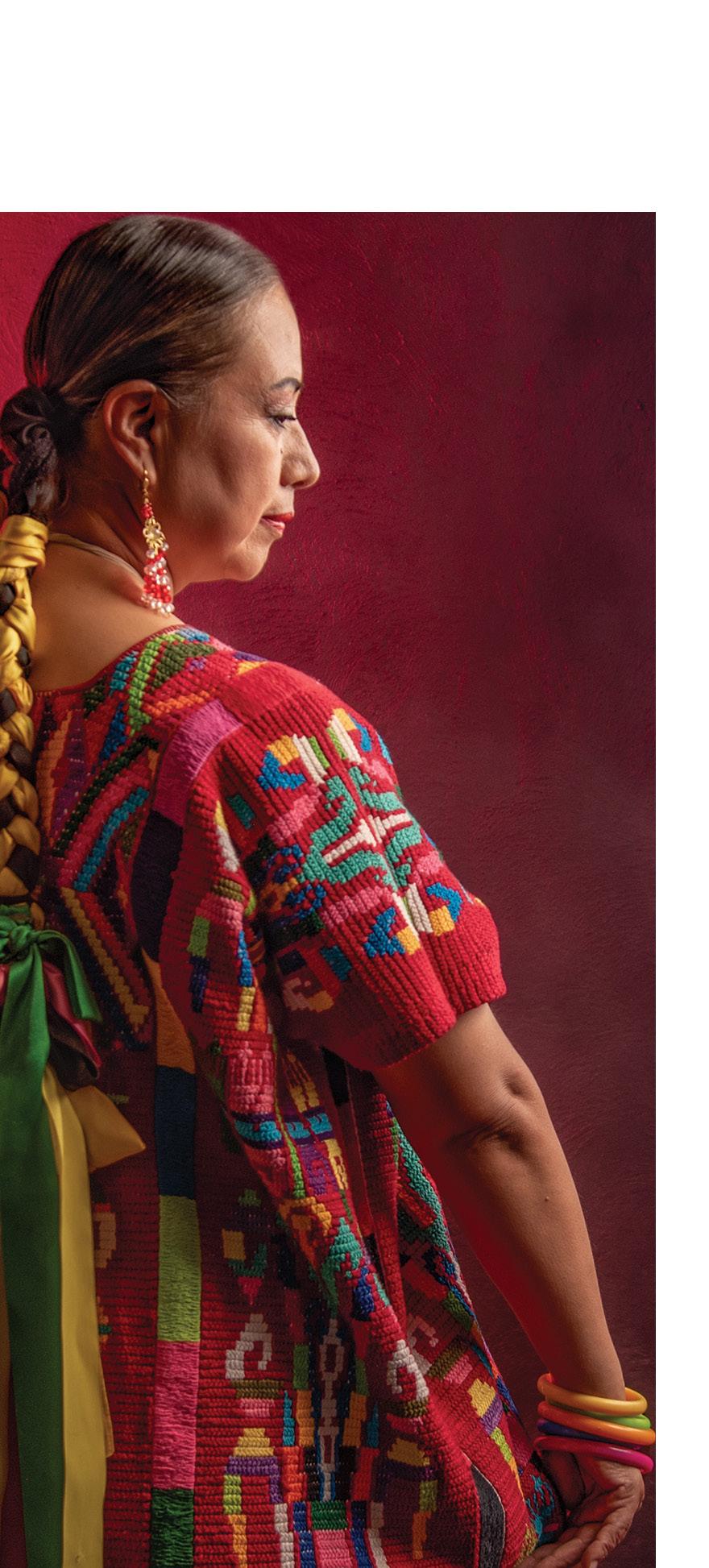

Cesar Estrada Chavez was born on March 31st, 1927, to a Mexican American descent family. In his early childhood, he grew up in Arizona and later moved to California, where he and his family became farm workers inspiring his fight for farmer’s rights. Chavez later served two years in the U.S. Navy and received an honorable discharge. After his honorable discharge, Chavez worked as a lumber handler in San Jose, where he helped set up a chapter of the Community Service Organization (CSO), a pivotal civil rights organization for Latinos in California. In 1958, he went on to become the general director of the organization. Chavez met Dolores Huerta while traveling to other CSO chapters. In 1962 they founded United Farm Workers (UFW) becoming primary figures for Latin America Civil Rights. The UFW seeks to empower migrant farm workers and improve their wages and working conditions.

Alexandria Ocasio-Cortez also known by her initials AOC is the youngest, Latina woman to serve in the United States Congress. AOC was born in 1989 in The Bronx, New York to a Puerto Rican mother and Bronx-born father of Puerto Rican descent. She completed high school and graduated from Boston University cum laude with a Bachelor of Arts in Economics and International Relations. Her father died in her sophomore year of college from Lung Cancer in 2008. After graduating college in 2011, she returned home and later campaigned for Senator Bernie Sanders in the 2016 Democratic presidential primary. AOC went on to challenge Democratic incumbent Joe Crowley and pulled off a surprising win making her the youngest person elected to the U.S. House of Representatives during the midterm elections in June of 2018. As of 2022, AOC has sponsored over 100 pieces of legislation, 15 of which are laws, making her a trailblazer in progressive politics.

Ellen Ochoa is the first Hispanic woman to go to space with a nine-day mission in 1993; making her an icon in the Hispanic culture. Ochoa was born in 1958 in Los Angeles, California. She received her physics degree from San Diego State and in the 1980’s she earned her master’s and doctorate degree from Stanford University’s Department of Electrical Engineering. Ochoa accepted a position at Sandia National Laboratories where she became a specialist in optical systems. She later became a research engineer at the Ames Research Center of the National Aeronautics and Space Administration (NASA). She is the co-inventor of three patents: an optical inspection system, an optical object recognition method, and a method for noise removal in images. In 1990, NASA selected Ochoa to participate in its astronaut program defining her role in history. She flew on board Discovery, a space shuttle, on a mission to study the Earth’s Ozone Layer. Further, she went on to fly in space four times and was the first Hispanic woman to do so. After retiring with 30 years in service, she continues to advocate for women in STEM, she told NBC News in 2019 “I think we need all the best and brightest people working in science and engineering fields, and that is certainly not limited to men or white men or anything like that.”
The contributions of Hispanic Americans to the world are profound and far-reaching, enriching every aspect of our lives from art and music to science and politics. By respecting and honoring different cultures, we celebrate the diversity that makes our societies vibrant and resilient. On our Luxeathon™ journey, it is the diverse people we meet and the shared experiences that truly make life worth living. Each individual’s unique background and story add depth and color to our collective narrative, reminding us that our differences are a source of strength and unity. As we continue to embrace and appreciate the myriad contributions of Hispanic Americans, we build a more inclusive and dynamic world for all.



Whether you are of Hispanic and Latin American descent, enjoy Hispanic and Latin American heritage cuisine, or want a new meal to spice up the week, many healthy and nutritious meals can be made and enjoyed by everyone in your residence hall or the comfort of your home. Hispanic and Latin American cuisine are known for its vibrant flavors, authentic ingredients, and dedicated preparation. During the month of October, we are breaking food fatigue and learning about and trying new foods with a Hispanic and Latin flare.
Here are 7 healthy versions of popular Hispanic and Latin dishes that will help you redefine healthy eating habits with some flare:
A typical empanada is a flour-based, deep-fried dough with various forms of savory meat fillings, including ground beef, ham, or chicken that can be either baked or fried. Making empanadas healthy is easy. Instead of butter in the dough, consider olive oil, this is a great alternative when cutting back on fat. Baking empanadas instead of deep frying them significantly takes out unhealthy saturated fat from your diet.
Did you know?
The Spanish verb empnar, means to coat or wrap in bread. Empanadas are said to originate from Spain, although many countries claim empanadas as their own.
Arroz con pollo which means “rice with chicken” is a much-loved Hispanic and Latin American dish that consists of spiced chicken, rice, onions, various spices, and vegetables of your choosing. This meal can be remixed to a healthier alternative. Swap white rice for brown rice for added benefits, such as energy, better digestion, and heart health. Arroz con pollo is traditionally made with chicken thighs, a dark, fattier meat. However, chicken thighs can be substituted for a lighter option like chicken breast.

Chili Rellenos is an authentic, traditional dish made with roasted poblano peppers with cheese, dipped in a fluffy egg batter, and fried until golden brown and can be smothered with a rich and flavorful sauce or served with red or green salsa. This recipe can be enjoyed during the season of Lent since they don’t contain any meat. These peppers also can be stuffed with a green chile and corn mixture topped with shredded Chihuahua cheese. A healthy alternative to the meal is baking the peppers; baking will give them a melted and crispy outer later without the use of oil. Using Greek yogurt base is also another alternative to consider because of the low carb content and gluten-free option.
Avocado-stuffed Ceviche is a refreshing appetizer or light meal that seafood lovers will fall in love with. Ceviche is raw fish and seafood cured in citrus juice and seasoned with herbs and spices. It is prepared with fresh, ripe avocados, filled with cooked and cooled, fresh fish or Ceviche, and combined with lime juice, cucumbers, tomatoes, cilantro, sliced chili, and red onion. In Latin culture, this cuisine is one of the most nutritious, light appetizers or meal.
Chimichurri sauce is a condiment and marinade that is boldly versatile and usually paired with skirt steak. Pairing chimichurri with salmon replaces the fattier red meat, giving the dish a high source of vitamins, and healthy Omega-3 fatty acids coming from the salmon. Rub the salmon with olive oil and sea salt and bake until tender and flakey; topping off with the chimichurri sauce this dish gives you an authentic flavor in a lighter way.
Tres Leches Cake which means “three milks” is a Latin American dish that consists of a sponge cake topped with a three-milk mixture. It is an airy, light, decadent dish. To create a healthier version, consider swapping all-purpose flour for whole wheat flour, or almond flour for a lower glycemic index and higher fiber content. The milk mixture can also be swapped for non-fat or low-fat milk, evaporated milk, or dairy-free coconut milk instead of heavy cream.
Churros are a popular fried dough made from a flour-based batter that is shaped into pipes and then goes into hot grease and fried until crispy then coated in cinnamon and sugar. The most common shape of churros is a thick stick with a ridge resembling French fries. With a few tweaks, churros can be a healthier option. Baking churros with whole wheat flour, a touch of coconut oil, and plant-based milk provides a healthy alternative. In addition, rolling the churros in a minimal amount of coconut sugar, instead of white, refined sugar is a healthy alternative too.
Cornucopia Creations
Crafting Zesty Corn Salsa
From the Track
It’s Giving Homecoming
Wellness Momentum
The Remix
Sustainable Style

Ocean Guardians
Hot Topics
Book Club


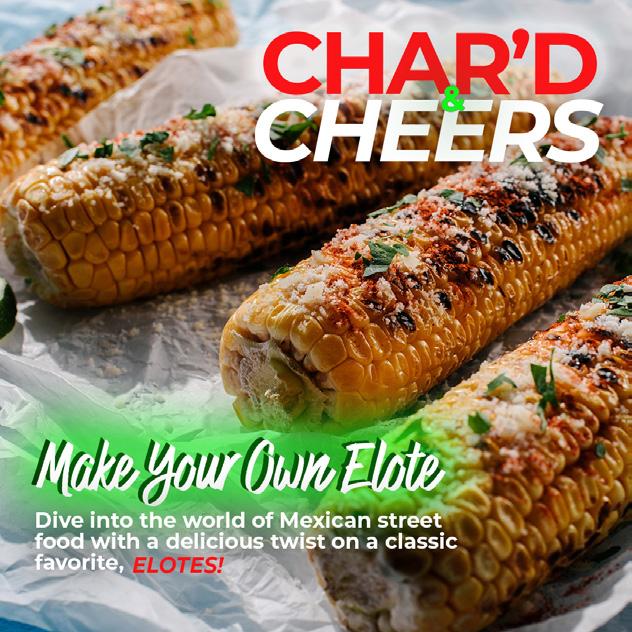







Breakfast is said to be the most important meal of the day, giving you the energy you need while tackling your Luxethon™. Much like any other meal, certain factors need to be met to have a healthy and wellrounded breakfast. A healthy breakfast should consist of protein, fiber, carbs, and healthy fats. By hitting these factors, you help round out a nutritious meal. This will help you fuel up for an extended amount of time, providing sustained energy. You can’t begin running without taking the time to fuel up, whether from breakfast, this month’s Endurance Eats, or the highlighted infused water from last month's issue. In Latin culture, many traditional foods are sure to make your morning meal great, such as eggs, rice, beans, and other starches like tortillas are common breakfast ideas. As you continue to celebrate Hispanic Heritage Month, try out some tasty traditional breakfast meals to add to your morning rotation.
1
2
3
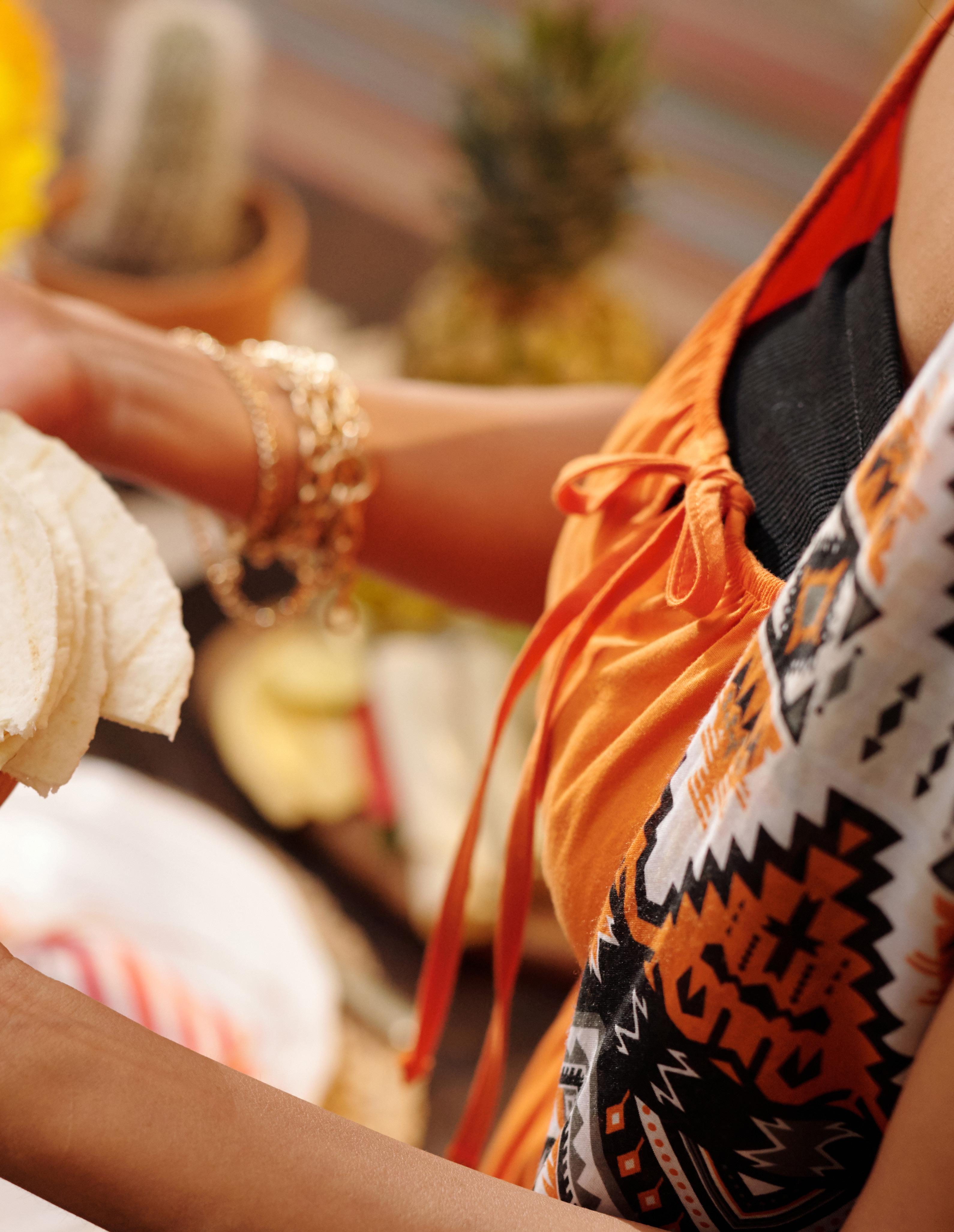
4
5
6
In Costa Rica, there is a traditional dish called Gallo Pinto. Gallo Pinto is rice and beans and is considered to be a hearty and delicious meal. This meal can be served alongside scrambled eggs, making it a good mix of protein, fiber, and carbs. Consider adding slices of avocado or tomato from Top That in your dining hall for an even more balanced plate.
In Mexico, Huevos Rancheros is a classic in Latino homes. Huevos Rancheros consists of corn tortillas, topped with refried beans, salsa, and eggs. This light and delicious meal can be served for breakfast, lunch, or dinner. For this Mexican classic, you will need scrambled eggs, a tortilla, refried beans for protein, and salsa. Start with the tortilla first, then your protein of choice, topped with refried beans and warm salsa. This meal can be garnished with cilantro, cheese, or avocado.
Molletes is a staple Mexican cuisine that is quick and easy to whip up in the dining hall before rushing to class. Molletes are typically served on bolillos. Bolillos is a type of savory bread made in Mexico and Central America. Insider Tip: If Bolillos are not present in your dining hall, any traditional sandwich roll will work. Consider putting them in the toaster oven before topping them with the ingredients, for a few minutes to make them crispy. For Molletes, you’ll need a layer of protein, traditionally beans would be the protein and shredded cheese. The Molletes go in the toaster oven at 350 degrees for 3-5 minutes and can be topped with pico de gallo.
Avena means oatmeal in Spanish. In Colombia, Avena also means a specific type of oatmeal shake. This cozy and delicious shake provides many health benefits and provides a refreshing take on oatmeal. The process of making Avena is easy, and all ingredients can be found in your campus dining hall. Avena is a combination of cooked oats that are chilled with milk.
Three ingredients and a skillet are all you need to make Venezuela's popular dish, Arepas. Arepas are crispy on the outside and tender on the inside. This dish has many different variations and is highly versatile. It is a cornbread made from ground corn flour. This savory bread can be slathered with butter, stuffed with scrambled eggs, or can be a sandwich sliced with avocado and cheese.
Morir Sonando is a refreshing drink that is often compared to the Orange Creamsicle popsicle. This classic Dominican Republic drink is a sweet combo of milk and orange juice. For additional flavor, hints of vanilla can be added. This is a simple but delicious beverage that can be made in your dining hall and be enjoyed throughout your morning.
As we celebrate Hispanic Heritage Month, let us honor the rich and diverse culinary traditions that span the Hispanic world. Breakfast, a meal that brings families together at the start of each day, offers a delicious glimpse into the vibrant cultures and histories that shape Hispanic communities. From the sweet mallorcas of Puerto Rico to the savory arepas of Venezuela, these dishes not only nourish the body, but also carry the flavors of heritage, storytelling, and togetherness. Embracing these breakfast traditions allows us to appreciate the profound and joyful impact of Hispanic culture in our daily lives.
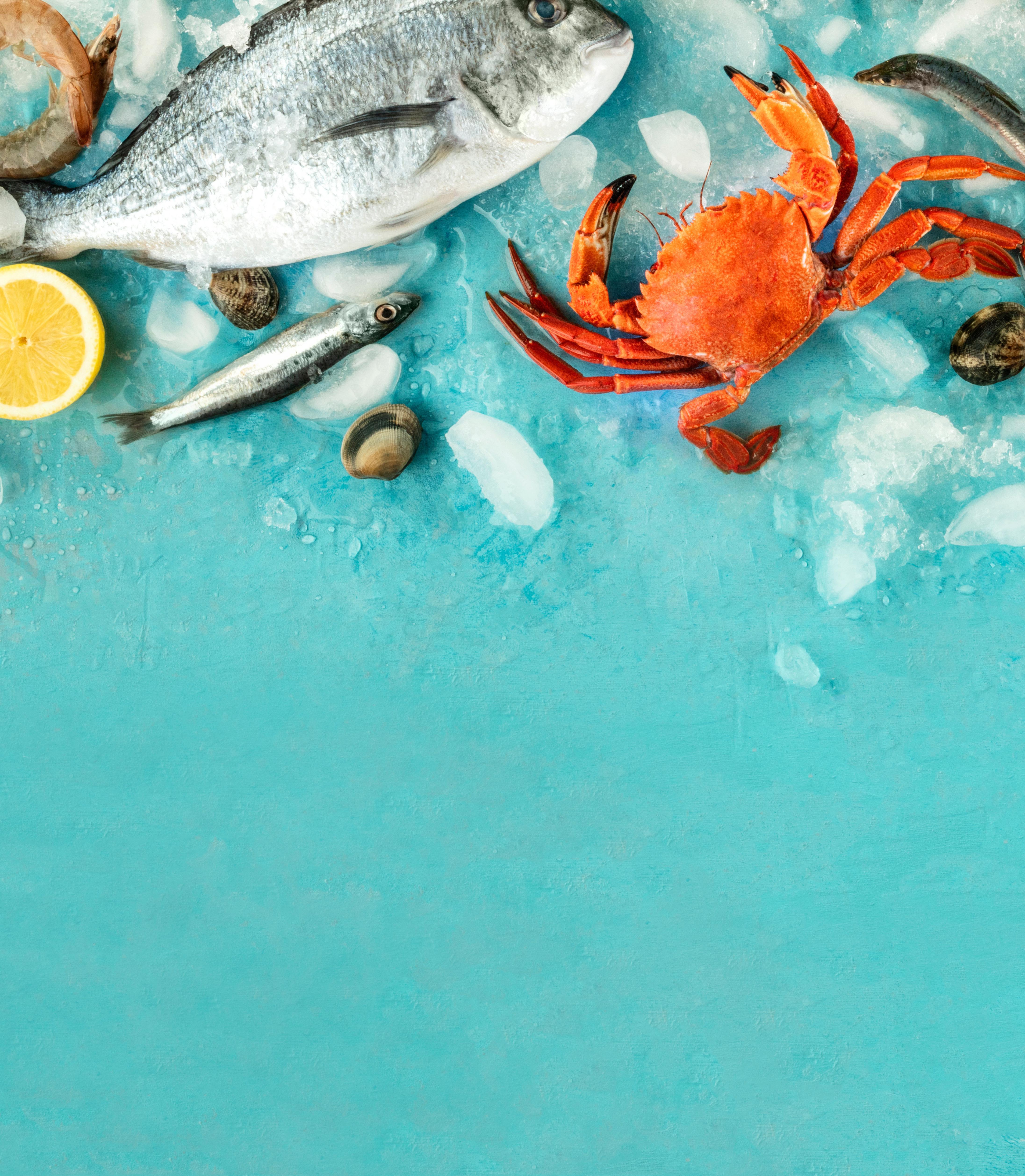
Seafood is a tasty source of protein and nutrients enjoyed by many people. However, many oceans are being overfished, causing damage to our oceans and threatening the future of our seafood supply. Following this guide will help you be more conscious of sustainable seafood supply and how to be more self-aware.
Sustainable seafood is the practice of catching, harvesting, or farming fish to ensure the species can maintain a healthy population, habitats to flourish, and productive ecosystems to be available for future generations. It is also the most environmentally efficient option. In contrast, overfishing and unsustainable fishing practices have led to the depletion of many seafood species. Consequently, these practices severely affect our ocean’s health and food supply.
In the U.S., seafood is sustainable due to the robust and dynamic science-based regulatory system. When choosing sustainable seafood, you are helping protect the environment and supporting local communities. In addition, this option can be more nutritious because of its freshness and containing fewer contaminants. Further, the U.S. is recognized as the global leader in sustainable seafood.
The U.S. being a global leader in sustainable seafood comes with a lot of plans, processes, and management. U.S. Wild-Capture Fisheries go through a science-based process that is developed by regional fishery management councils. These plans are developed through an open, public process using the best scientific information available
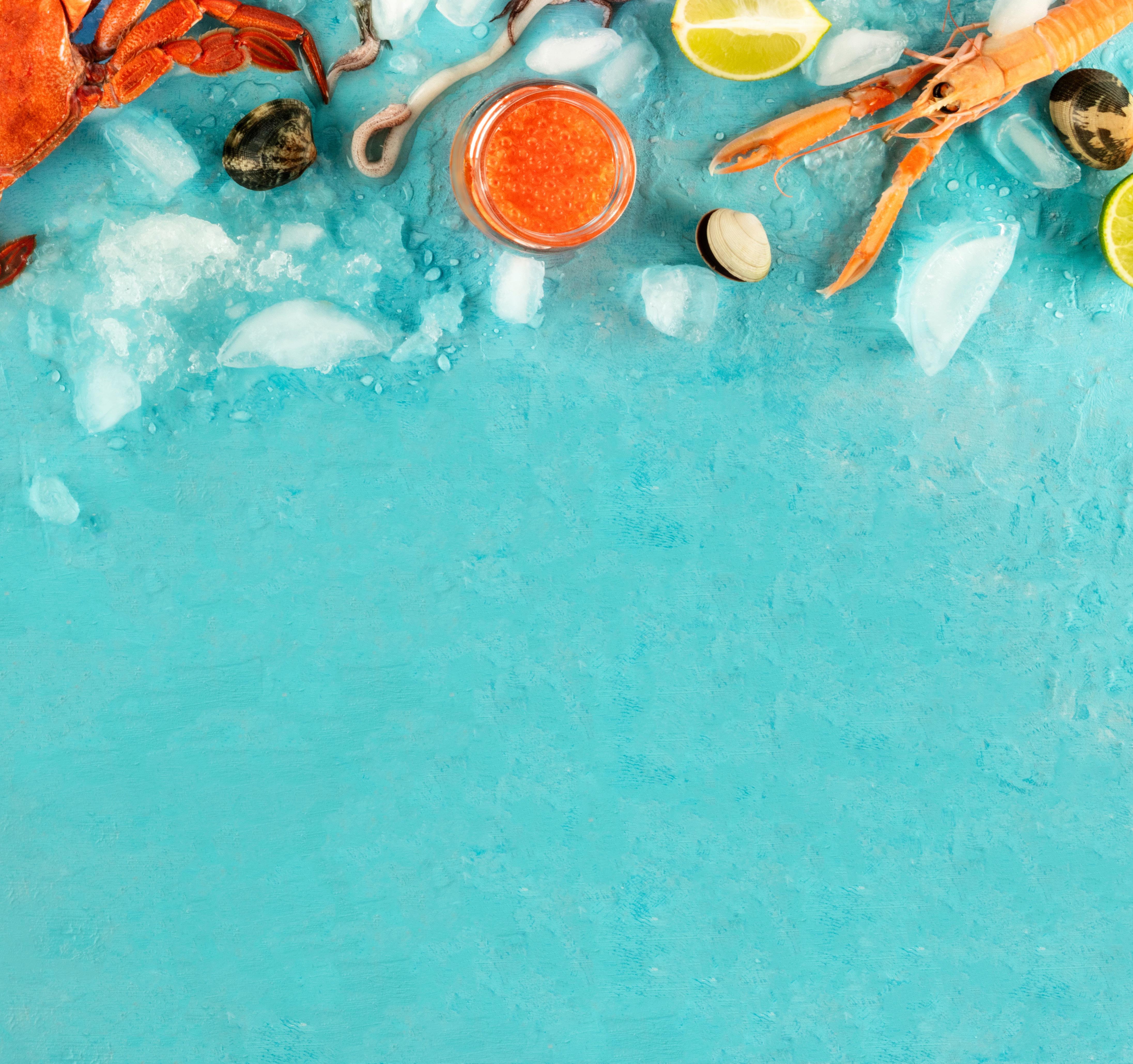
According to the National Oceanic and Atmospheric Administration Fisheries (NOAA), the nation’s ocean resources, by law, U.S. seafood must be caught according to the following:

• Considering social and economic outcomes for fishing communities
• Preventing overfishing
• Rebuilding depleted stocks
• Minimizing bycatch and interactions with protected species and identifying and conserving essential fish habitats.
This process maintains our future supply while allowing the species to reproduce.
The benefits of being seafood conscious are not only good for the environment, but it’s also good for our health and our economy. Being seafood conscious helps:
• Protect Marine Ecosystems - Protecting marine ecosystems aids in preventing the depletion of fish stocks and the use of unsustainable fishing techniques that can harm habitats.
• Reducing the Risk of Contamination - Consuming sustainable seafood typically offers a safer option since it involves methods that minimize the possibility of harmful exposures, like mercury.
• Provides Important Nutrients - Seafood is an excellent source of essential nutrients such as vitamin D, omega-3 fatty acids, and protein.
Thompson Hospitality has committed to doing its part by sourcing sustainable seafood and serving environmentally responsible seafood for its different business endeavors. We’ve partnered with Monterey Bay Aquarium, the leading source of science-based information for sustainable seafood around the world, to ensure we do our part.
; Sourcing local and regional ingredients.
; Getting proteins from suppliers that promote the humane welfare of farm animals.
; Using food that is minimal or free of chemicals and antibiotics.
; Supporting campaigns that reward the efforts of farmers and laborers.
; Fostering responsible behavior and practice in our collegiate units through our Sprint Print campaign.
“The ocean was thought of as a dumping ground for so long, there was a sense that there was no way we could harm it because it is so vast.”
-Caitlyn Toropova of the International Union for Conservation of Nature (IUCN)
Our ocean provides us with countless advantages and inevitably, disadvantages. These advantages provide climate regulation, transportation, economy, and recreation. The disadvantages come from human activities, such as destructive fishing, coastal development, bottom trawling, and pollution.
Taking the time to learn both the advantages and disadvantages of how the ocean affects us and the world around us is extremely important because life on the planet depends on the ocean.
The ocean covers 70% of the world, regulating the Earth’s temperature. The ocean does this by absorbing the sun's radiation; this helps heat the planet. The ocean also stores and releases heat. Storing heat in the ocean ten feet below can heat the entire atmosphere and can warm the planet for decades. The ocean releases heat stored by evaporation, melting ice shelves, and reheating the atmosphere.
Transportation is one of the oldest options for transporting goods or cargo, it's one of the most available because the ocean covers most of our planet. Consequently, 90% of freight is transported through the oceans and waterways. Did you know until the mid-twentieth century ships were the only mode of transportation for ocean crossings? With so many advantages, there are many more disadvantages to the world ocean. Marine Protected Areas (MPA’s) help with most of the disadvantages. A MPA is a region of the ocean where human activity is limited.



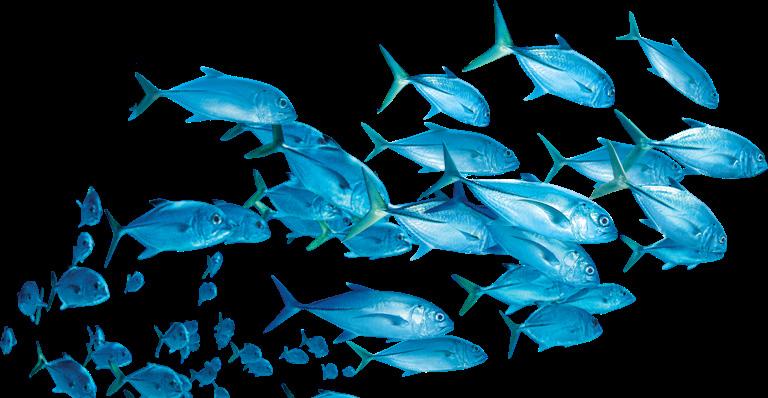

The ocean’s economy or “blue economy” produces 282 billion in goods and cargo. The “blue economy” is the sustainable use of ocean resources for economic growth, improved livelihoods and jobs, and the ocean ecosystem’s health. The ocean is the Earth’s most valuable asset, and the U.S. depends heavily on it. The ocean also provides a reliable source of protein and nutrition, as well as a source for many jobs.
Snorkeling, boating, and swimming are just a few of the many Marine Recreational Activities (MRA) that contribute to unique experiences that can be done on or in the water. Many MRA’s provide benefits for the person partaking. According to a survey done by Pew Environment Group, a conservation branch of The Pew Charitable Trust, 121 million people enjoyed MRA’s and concluded that there are large economic benefits, but some activities could impact ecosystems in many ways.
Destructive fishing is the practice of harming fish habitats, the environment, marine species and/or having negative impacts on people’s livelihoods. This practice can harm and potentially damage ecosystems. A fishing practice that contributes to this is bottom trawling; a fishing method in which a large net with heavy weights drags across the ocean floor, scooping up everything in its path, destroying fragile habitats and sponge ecosystems.
Coastal development provides economic benefits; however, the development negatively impacts coastal ecosystems. Coastal Development is the development of buildings that humans create along the coastline for the purpose of tourism. Coastal development also contributes to climate change and ocean acidification. Sediment remains may run into coastal habitats, which can smother corals, seaweed, and sensitive marine habitats. These remains can also reduce the amount of light available for photosynthesis.
Debris uses oxygen and over time the debris starts to break down. This breakdown leads to low oxygen levels in the ocean. The depletion of low levels of oxygen can kill marine animals such as sharks, penguins, and sea turtles. In addition, noise pollution contributes to disadvantages in the ocean. Ship traffic can harm marine species that rely on sound signals to survive and reproduce.
Protecting the marine ecosystem is essential for preserving the health and beauty of our oceans for future generations. By understanding and advocating for sustainable practices, we maintain the delicate balance of marine life that supports our planet. For Luxeathoner™, leading a luxe life extends beyond personal success; it encompasses a deep respect for our environment and a commitment to its preservation. By embracing sustainability and promoting marine conservation, we honor the ocean's bounty, ensuring that we and future generations can continue to enjoy a truly luxurious and harmonious life.




Marketing Contacts
Daniela-Gabrielle Smallwood, Vice President of Marketing and Programming
daniela.smallwood@thompsonhospitality.com (571) 446–7430
Stacey Gibson, Director of Retail Marketing
stacey.gibson@thompsonhospitality.com (571) 524–8566
Editorial Staff
Gina Godwin, Creative Director
Yolanda Waters, Chief Editor
Heaven Smallwood, Editor
Jacquii A. Tilley, Contributing Writer
Joellen Allah-Mensah, Graphic Designer